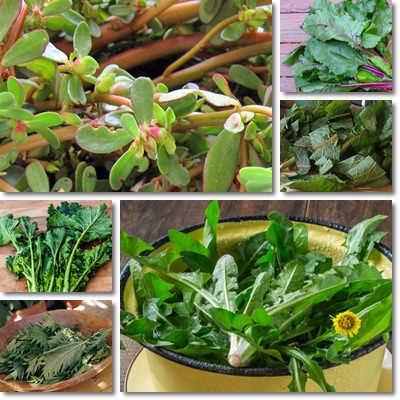Humanity has come so far in terms of food and nutrition that we now forsake some surprisingly nutritious greens that we once relied heavily on for proper nourishment. But some of these not so mainstream greens we might not throw a second glance at are actually perfectly fit for human consumption and surprisingly nutritious.
From vitamin C and vitamin K to calcium, iron, potassium, manganese and even healthy fatty acids such as Omega-3 and Omega-6, these 10 discarded and highly disregarded greens are great options for any healthy eater.
They grow in gardens, parks, forests, on the side of the road, on river banks or in the field, but are also cultivated by a small number of weed connoisseurs which are aware of their nutritional value and health benefits.
However, the average person might regard them as invasive weeds overpowering their garden or best to discard parts of a vegetable they only know for half of its value. Yet these 10 underdogs of the vegetable world listed below are nutrient packed culinary delights.

1) Stinging nettle (Urtica dioica).
Stinging nettle, or the common nettle, is a leafy vegetable and medicinal herb popular in traditional European cuisine. Despite the painfully stinging hairs on its leaves and stems, the plant is surprisingly nutritious, containing vitamins C, E, B2, B5 and small amounts of pro-vitamin A carotenoids.
Nettle also provides trace amounts of Omega-3 in the form of alpha-linoleic acid. The plant is best known for its diuretic and detoxifying properties, and claimed to help cleanse the blood of toxins.
Poultices made from the leaves and stems of the plant have been traditionally used to treat muscle and joint pain as a result of arthritis, but also eczema and insect bites.
Nettle herbal infusions are said to help improve urinary tract health, while root extracts are used for managing BPH symptoms such as constant urge to urinate, incomplete bladder emptying or dripping.
Overall, eating nettle is believed to have an overall strengthening effect, hence its use in anemia management.
2) Purslane (Portulaca oleracea)
Purslane is a garden weed and a succulent leaf vegetable with tiny, green leaves and reddish stems. It can often be seen appearing around tomato plants, but makes a good companion plant for many crops.
The leaves, stems and yellow flowers are all edible and can be consumed raw or cooked.
Purslane has a bitter-green taste as a result of its oxalic acid and malic acid content and is a great source of vitamin C (21 mg) and vitamin E (12.2 mcg).

Purslane provides generous amounts of healthy Omega-3 fatty acids in the form of alpha-linoleic acid, but also trace amounts of eicosapentaenoic acid (a superior form found in fish sources).
In addition to vitamins B2, B6, B1, B3 and folic acid, the vegetable boasts generous amounts of minerals such as magnesium, iron, manganese, potassium, calcium, phosphorus and zinc.
The reddish stems and the greenish-yellow leaves are a result of betacyanin pigments (betalain and betaxanthins) with surprising antioxidant and anticancer properties.
3) Patience dock (Rumex patientia)
Also called garden patience, stevia or monk’s rhubarb, patience dock is a spring leafy vegetable and garden weed. Its leaves are particularly appreciated in traditional East European cuisine, while its seeds and roots are collected for medicinal purposes.
Patience dock boasts strong diuretic and detoxifying properties, regulating intestinal transit, relieving constipation and reinvigorating the body.
The roots are traditionally used for treating low blood pressure, palpitations and cardiovascular and circulatory problems in general.
This leafy green has soft, rounded, large, dark green leaves and a typical bitter, green vegetable taste. Just like spinach, purslane, nettle and most greens, patience dock contains oxalic acid, which can be dangerous for our kidneys in large amounts, hence the recommendation to blanch the leaves, dip them in hot water for a couple of seconds prior to eating, or resume to only consuming very little amounts of the fresh green.
While it can be consumed raw in salads (watch out for its oxalic acid content), it is often stuffed with meat, rice etc. and boiled or made into dock broth. Patience dock is also a good choice for anyone looking to lose some weight in a healthy manner.
4) Beet greens (Beta vulgaris)
Many people often discard beet greens without realising their nutritional value and health potential. Despite being particulalry rich in oxalic acid, the stems and leaves of the beet plant are also a good source of a wide range of vitamins and dietary minerals.
Beet greens are rich in antioxidants and help protect cells and DNA against potentially cancerous mutations.
100 g of raw beet greens contains about 400 mcg of vitamin K, more than 4 times the minimum daily requirement of an average adult.
Vitamin K not only boasts excellent anti-inflammatory properties, but also promotes blood coagulation and prevents blood loss. The leafy green is also a good source of vitamins A and C, B vitamins, magnesium, potassium and a rich source of calcium.
5) Turnip greens (Brassica rapa)
Green and bitter, turnip tops or turnip greens are an excellent source of vitamin K, providing more than 3 times the minimum daily requirement of an average adult, as well as generous amounts of vitamin C, folate, vitamins B6, E and B5.
Turnip green are particularly rich in carotenoid compounds, lutein and zeaxanthin, but also calcium and manganese.
Regular consumption provides a variety of antioxidants and exerts a protective effect on our eyesight in particular.
The high amount of calcium in the greens contributes to osteoporosis prevention and management, while the wide range of B vitamins and other dietary minerals add to restorative and strengthening effect of the vegetable.
Like its fellow underdog greens, turnip tops successfully regulate intestinal transit, relieve constipation and contribute to weight loss in a healthy manner.
6) Dandelion greens (Taraxacum officinale)
Bitter but healthy, dandelion greens are a great source of vitamins K, A and C and support blood coagulation, eye health and immunity. In addition to this, the greens contain calcium, manganese and potassium, minerals with an overall tonic effect.
The toothed leaves are often used raw in salads and paired with other bitter greens, nuts (walnuts, pecans, almonds), goat cheese, radishes, tomatoes or even fruit (strawberries or kiwifruit, lemon juice, raisins) and soft cheeses.
7) Mustard greens (Brassica juncea)
Like most leafy greens, mustard greens are a great source of vitamins K, A and C as well as a good source of vitamin E and B vitamins, calcium and iron.
In addition to supporting blood coagulation, boosting immunity and improving eye and mucous membranes health, mustard greens have a tonic effect.
Regular consumption of steamed mustard greens is encouraged and believed to have a positive effect on vascular health, reduce inflammation levels and engender a reduction in overall cancer risks.
8) American cress (Barbarea verna)
Also called land cress, bank cress or early wintercress, American cress is similar in appearance and taste to watercress. It is rich in vitamins K and C as well as beta-carotene, lutein and zeaxanthin, all of which promote good blood coagulation, support immunity and exert a potent anti-inflammatory and antioxidant action.
Vitamin K is also believed to play a role in osteoporosis prevention and management, while vitamin C promotes fast wound healing, delays wrinkles and has antiviral properties.
9) Indian spinach (Basella alba)
It is a climbing, leafy green, semi-succulent plant with heart shaped leaves. It has a mildly bitter taste and provides generous amounts of vitamins A (400 mcg, about half of the RDA) and C (102 mg or 120%), as well as manganese, magnesium, potassium, calcium and iron.
It is a particularly good food for bone health, but also supports immunity and boats anti-inflammatory properties. Indian spinach greatly favors cardiovascular health.
10) Prickly lettuce (Lactuca serriola)
A member of the daisy family, the prickly lettuce (or scarole) is a bitter, leafy green vegetable with good diuretic properties and a generous vitamin K content.
Low in calories but nutritious, it is a good source of vitamin A, carotenoids and vitamin C. Similar to its fellow disregarded green, it has an overall refreshing effect and contributes to good digestion and cardiovascular health.
Conclusion
All of these healthy greens are not generally stars in our kitchens, but including them in our diet can engender numerous health benefits as a result of their high nutritional value.
However, because of their extremely high vitamin K content, they might not be the best choice for people under anticoagulant medication because they can interact with the blood thinning medicines and encourage blood clot formation.
It is best to talk to your doctor about how much leafy greens you can eat in this case. As for their bitterness, they are actually quite flavorful once you acquire the taste.
